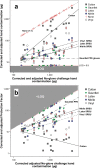The Short-term Protective Effects of 'Non-PPE' Gloves Used by Greenhouse Workers
- PMID: 26240197
- PMCID: PMC4593184
- DOI: 10.1093/annhyg/mev051
The Short-term Protective Effects of 'Non-PPE' Gloves Used by Greenhouse Workers
Abstract
Task-based worker exposure assessments are used in regulatory product approval for pesticides. Some agricultural workers may be exposed to pesticide residues predominantly via transfer to the hands during plant tending or crop harvesting. They may use thin 'splash-resistant single-use' (SRSU) gloves or cotton gloves as good industry practice, for example, to protect a delicate crop from bruising, rather than specifically for chemical protection. These 'non-personal protective equipment (PPE)' gloves may or may not have been tested for chemical resistance, but can nevertheless give limited protection from chemicals. This paper reports experiments to assess the protection factors (PFs) of 'non-PPE' gloves against chemicals, to better inform the regulatory exposure assessments.One type of lightweight cotton and three types of 0.1 mm SRSU gloves 25cm long (latex, nitrile, and vinyl) that might be used as 'non-PPE' gloves and one type of 0.4 mm PPE nitrile gauntlet 33cm long were worn by 36 volunteers in greenhouses at four nurseries, handling plants sprayed with transferable but non-permeating strontium acetate in four consecutive 1-h sessions, including one session in which no gloves were worn. Dislodgeable foliar residues were measured by rinsing leaves in bags. Each subject carried out their task such as weeding or trimming, for their four sessions on their set of plants. Handwashes followed each session, and the washings were sampled and analysed for strontium. Unprotected hand contamination was taken to be the within-subject 'challenge' in the absence of gloves. It ranged from 166 to 4091 µg equivalent of strontium acetate on the hands and increased with increasing foliar residues. Geometric mean PFs were 60 (95% CI 38-87, n = 22) for PPE gauntlets, 32 (25-41, n = 65) for SRSU gloves and 5.3 (3.5-8, n = 21) for lightweight cotton. The PFs offered by the waterproof gloves (gauntlets and SRSU) increased with challenge, but for the absorbent cotton gloves it decreased. The measurement of protection is restricted by the limit of quantification (LOQ) such that protection must apparently increase with challenge, nevertheless the above trends remained even after removal of data <LOQ. For the waterproof gloves, protection was similar for dry and wet tasks. For cotton gloves, protection was lower for wet tasks, although this might have been consistent with that decreasing trend, because the ungloved hand challenges were higher for wet tasks than dry.Default PF values for cotton and SRSU non-PPE gloves may be taken for regulatory exposure assessments from lower quantiles of the distributions of PF results, being 1.3 and 7-10 respectively. The lower quantiles for cotton gloves are close to one, indicating no protection at all.
Keywords: agriculture; exposure assessment; gloves; handwash; pesticide residues; protection factor; surface transfer.
© The Author 2015. Published by Oxford University Press on behalf of the British Occupational Hygiene Society.
Figures

References
-
- Ansell Healthcare. (2008) Ansell glove permeation and degradation data. 8th edn. Form No. CRG-GC. 9/08. Available at www.ansellpro.com/download/Ansell_8thEditionChemicalResistanceGuide.pdf. Accessed July 2015.
-
- Brouwer D, Boeniger M, van Hemmen JJ. (2000a) Handwash and manual skin wipes. Ann Occup Hyg; 44: 501–10. - PubMed
-
- Brouwer D, de Vreede J, Meuling W, et al. (2000b) Determination of the efficiency for pesticide exposure reduction with protective clothing: a field study using biological monitoring. In Honeycutt RC, Day E, editors. Worker exposure to agrochemicals. Baton Rouge, FL: CRC Press; pp. 63–84.
-
- Cherrie J, Semple S, Brouwer D. (2004) Gloves and dermal exposure to chemicals: proposals for evaluating workplace effectiveness. Ann occup Hyg; 48: 607–615. - PubMed
Publication types
MeSH terms
Substances
LinkOut - more resources
Full Text Sources
Other Literature Sources
Medical

